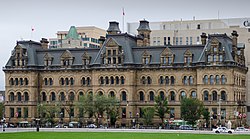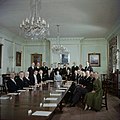King's Privy Council for Canada
The King's Privy Council for Canada (KPC; French: [Conseil privé du Roi pour le Canada] Error: {{Lang}}: text has italic markup (help); called the Queen's Privy Council for Canada when there is a queen[1][2]), sometimes called just the Privy Council,[3] is a group of people that help the monarch (king or queen) of Canada. They give advice to the monarch on events related to the government. The monarch or the person that represents them (the Governor General) must follow the advice of a group of people in the Privy Council, called the cabinet, who are usually part of the government and are usually Members of Parliament (MPs). Those who are part of the Privy Council are called "Privy Councillors".
| King's Privy Council for Canada | |
|---|---|
 The Office of the Prime Minister and Privy Council, where the Privy Council and Prime Minister work | |
| Abbreviation | Privy Council, KPC |
| Formation | 1867 |
| Legal status | Non-executive advisory body |
| Membership | List of current members |
| Monarch of Canada | Charles III |
| President of the Privy Council | Dominic LeBlanc |
| Clerk of the Privy Council | Ian Shugart |
| Website | {{URL|example.com|optional display text}} |
When people join the Privy Council, they become members of it for the rest of their lives. They are chosen by the Governor General based on who the Prime Minister says should be in the council.[4] That causes many of the Privy Councillors to be ex-members of the cabinet. Other Privy Councillors might be people that have important roles, like being the Leader of the Opposition.
King's Privy Council For Canada Media
Andrew Scheer, then leader of the opposition, being sworn into the Privy Council at Rideau Hall in 2017
Prince Edward (front row, fifth from left), at Rideau Hall, in Ottawa, two days after being appointed to the King's Privy Council for Canada
The first meeting of the Privy Council before the reigning sovereign; in the State Dining Room of Rideau Hall. Queen Elizabeth II is seated at centre, with Prince Philip, Duke of Edinburgh, to her left, and Prime Minister John Diefenbaker at her right; 14 October 1957.
References
- ↑ Official Report of Debates, House of Commons. Vol. 174. Queen's Printer. 1926. p. 5237.
- ↑ Pike, Corinna; McCreery, Christopher (2011). Canadian Symbols of Authority: Maces, Chains, and Rods of Office. Dundurn. p. 258. ISBN 978-1-4597-0016-1.
- ↑ Privy Council Office. "Queen's Privy Council for Canada – Facts". Queen's Printer for Canada. Archived from the original on 6 June 2011. Retrieved 15 October 2009.
- ↑ Hodgetts, J.e. (7 February 2006). "Privy Council". The Canadian Encyclopedia. Retrieved 13 May 2020.
Other websites
- Lua error in Module:Official_website at line 90: attempt to index field 'wikibase' (a nil value).


